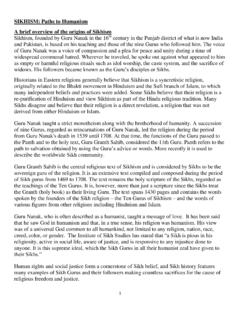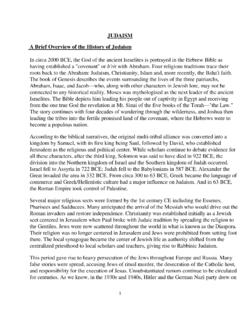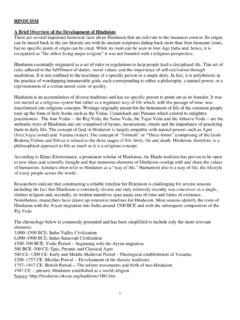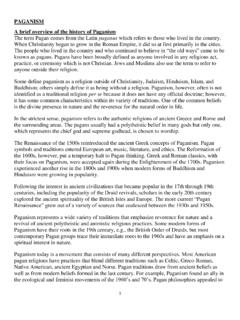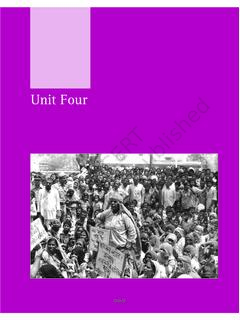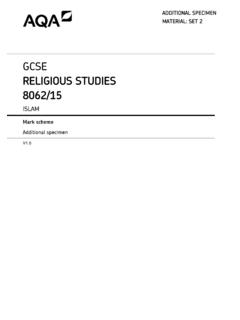Transcription of ISLAM A Brief Overview of the History of Islam
1 1 ISLAM A Brief Overview of the History of ISLAM The origin of ISLAM is placed around 610 CE when Muhammad, a highly spiritual and religious man who spent months in praying and self contemplation in a secluded cave near the town of Mecca, is thought to have received divine messages. The story is that one morning Muhammad heard the voice of the angel Gabriel and, through him, Allah spoke words of wisdom. The words were first recited by Muhammad, later his disciples, and then recorded as text which came to known as the Holy Qur an.
2 Thus followers of ISLAM consider the Qur an not the work of Muhammad but as direct revelations from Allah. ISLAM , which literally means submission, was founded on the teachings of the Prophet Muhammad as an expression of surrender to the will of Allah. The Qur an, the sacred text of ISLAM , contains the teachings of the Prophet that were revealed to him from Allah. Traditional Muslims believe that Allah is the one true God with no partner or equal and that the inspiration of this belief system comes straight from God and the vehicle chosen by him to deliver these teaching to the general population, the Prophet Muhammad.
3 Muhammad is said to have returned from the cave a changed man. The first person he preached to on his return was his wife Khadija, who became the first disciple of this new religion. Muhammad, encouraged by this, began to preach the revelations to the public at large through his sermons. Many people were impressed by verses of the Qur an and converted to ISLAM out of their free will. However, since the growing popularity of ISLAM jeopardized Muhammad s and his disciples lives, the entire community moved from Mecca to Medina circa 622 CE.
4 This move became a crucial event in the History of ISLAM and came to be known as Hijra. The Muslim calendar begins with the day of this migration. The people of Medina accepted ISLAM with and the spread of this new religion gained momentum. Later with well-organized finances and a vast army, Muhammad conquered and converted Mecca as well. He did not stop here but sent numerous emissaries to different parts of Arabia. Today ISLAM remains one of the most flourishing religions in the world; it is the second largest with around 23% of the earth s population identifying as Muslim.
5 The main teaching in the Qur an is the belief in Allah, the one and true God. The followers of ISLAM are traditionally divided into two main branches, the Sunni and Shia. Each group, although they follow the same religion, interpret certain events and teachings of ISLAM differently. Source: Birth of ISLAM ( ) Many medieval Muslim thinkers pursued humanistic, rational and scientific discourses in their search for knowledge, meaning and values. A wide range of Islamic writings on History and 2 philosophical theology show that medieval Islamic thought was open to the humanistic ideas of individualism, secularism, skepticism and liberalism.
6 ISLAM , of course, has an extensive History . The chronology below has been considerably shortened to include some of the key dates. For a more detailed version, see: 610 CE. According to traditional Muslim belief, at the age of 40 Muhammad is visited by the angel Gabriel who recites to him the first revelations of the Qur an and informs him that he is God s prophet. Later Muhammad is told to call his people to the worship of the one God, but some are hostile and persecute him and his followers. 622 CE.
7 After enduring persecution in Mecca, Muhammad and his followers migrate to the nearby town of Yathrib (known as Medina) where the people there accepted ISLAM . This marks the hijrah or emigration and the beginning of the Islamic calendar. Muhammad establishes an Islamic state based on the laws revealed in the Quran. 630 CE. Muhammad returns to Mecca with a large number of his followers. He enters the city and eventually all its citizens accept ISLAM . The prophet clears the idols and images out of the Kaaba and rededicates it to the worship of God.
8 1000 CE. ISLAM continues to spread throughout Africa. 1099 CE. The European Crusaders capture Jerusalem from the Muslims. Eventually Muslims regain control of what they view as their holy land. 1120 CE. ISLAM continues to spread throughout Asia. Malaysian traders interact with Muslims who teach them about ISLAM . Circa 1800 CE. Approximately 30 percent of Africans forced into slavery in the United States are Muslim. 1870-1924 CE. Muslim immigrants from the Arab world voluntarily come to the United States until the Asian Exclusion Act is passed in 1924.
9 1952 CE. The McCarren-Walter Act relaxes the United States ban on Asian immigration. Muslim students come to the from many nations. 1965 CE. Revisions of immigration law further open the doors for Muslim immigration. The Key Principles of ISLAM The unifying characteristics of ISLAM are the Five Pillars of ISLAM . The five pillars are the most important obligations of a Muslim under Sharia law and which conservative Muslims perform 3 faithfully. They are the foundation of traditional Muslim life and have been described in this way: -- Shahadah: The testimony that there is none worthy of worship except God and that Muhammad is his messenger.
10 -- Salah: Establishing of the five daily prayers -- Zakat: The giving of charity which is one fortieth ( ) of the net worth of possessions kept for more than a year, with few exemptions, for every Muslim whose wealth exceeds the nisab, and 10% or 20% of the produce from agriculture. This money or produce is distributed among the poor. -- Ramadhan: Fasting from dawn to dusk in the month of Ramadan. -- Hajj: The pilgrimage to Mecca during the month of Dhul Hijjah, which is compulsory once in a lifetime for one who has the ability to do it.
